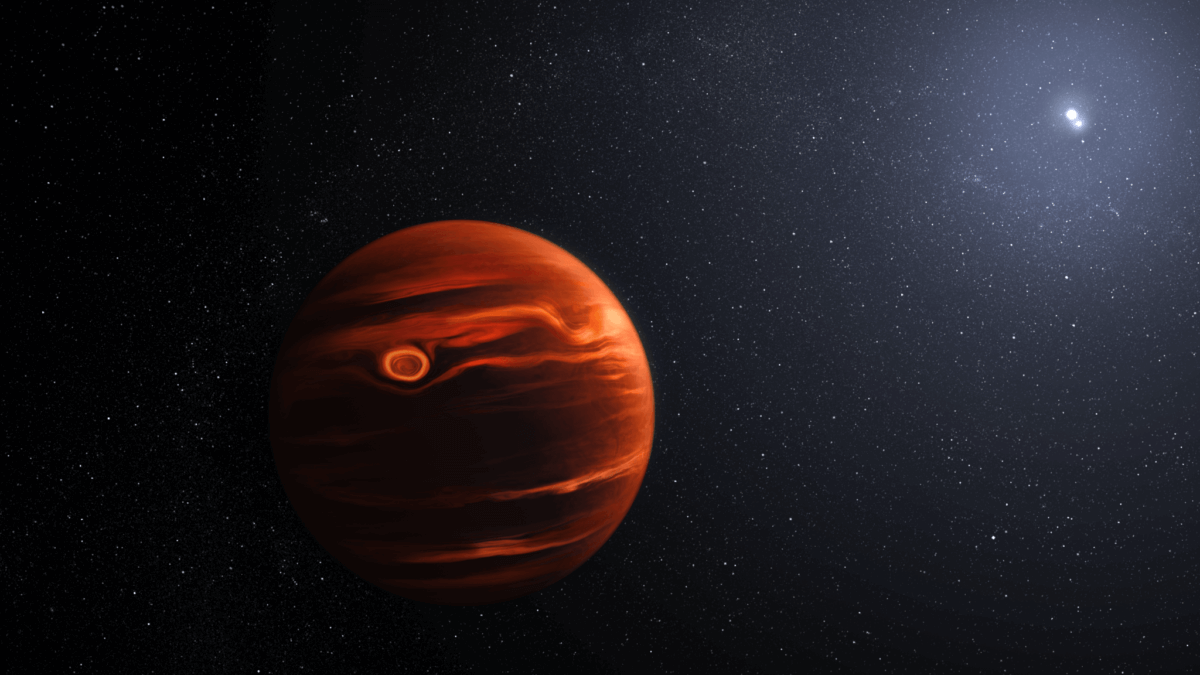
This illustration conceptualizes the swirling clouds identified by the James Webb Space Telescope in the atmosphere of exoplanet VHS 1256 b. The planet is about 40 light-years away and orbits two stars that are locked in their own tight rotation. Its clouds, which are filled with silicate dust, are constantly rising, mixing, and moving during its 22-hour day. (Credits: Illustration: NASA, ESA, CSA, Joseph Olmsted (STScI))
SANTA CRUZ, Calif. — NASA’s Jame Webb Space Telescope (JWST) has detected swirly-looking clouds in the atmosphere of a distant planet. The exoplanet is known as VHS 1256 B and has a fluctuating atmosphere that is constantly changing during its 22-hour day. The latest findings report the largest number of molecules ever seen at once on a planet outside our solar system.
“No other telescope has identified so many features at once for a single target,” says Andrew Skemer, a researcher at the University of California, Santa Cruz and study author in a press release. “We’re seeing a lot of molecules in a single spectrum from Webb that detail the planet’s dynamic cloud and weather systems.”
VHS 1256 B is about 40 light-years away and orbits two stars over a 10,000-year period. It’s four times farther away from its stars than Pluto is from our Sun. This distance gives the JWST a great visual of the exoplanet because the stars are not interfering with the planet’s light. In other words, this was one of the few instances astronomers were able to observe the planet directly instead of relying on a transit technique or a coronagraph (a telescope attachment used to block out light from a star) to gather data.
The remote planet contains clouds filled with silicate dust that is constantly rising, mixing, and moving around. As a result, hotter material rises up and cold material rises down. Clouds can reach scorching temperatures of up to 1,500 degrees Fahrenheit. Because the planet has low gravity, the silicate clouds are way up high in the atmosphere for the JWST to clearly see. The telescope identified both larger and smaller silicate dust grains in the clouds, similar to tiny particles in smoke.

“There’s a huge return on a very modest amount of telescope time,” describes Beth Biller, a researcher at the University of Edinburgh and co-author of the study. “With only a few hours of observations, we have what feels like unending potential for additional discoveries.”
Another reason why the atmosphere in VHS 1256 B is constantly changing is because of its age. Compared to other planets, this exoplanet is pretty young. It formed only 150 million years ago, and over time, astronomers expect it to cool over in the next billions of years.
With all of the exoplanet’s atmospheric changes, VHS 1256 B has some of the most dramatic changes in brightness ever seen in a planetary-mass object. Astronomers also identified water, methane, and carbon monoxide along with evidence suggesting the presence of carbon dioxide.
“We’ve identified silicates, but better understanding which grain sizes and shapes match specific types of clouds is going to take a lot of additional work,” says Brittany Miles, a researcher at the University of Arizona and study coauthor. “This is not the final word on this planet – it is the beginning of a large-scale modeling effort to fit Webb’s complex data.”
The study is scheduled to be published in The Astrophysical Journal Letters.











Some amazing data, wow, maybe even carbon dioxide?we are not alone?hi there E.T!!!!!!!!